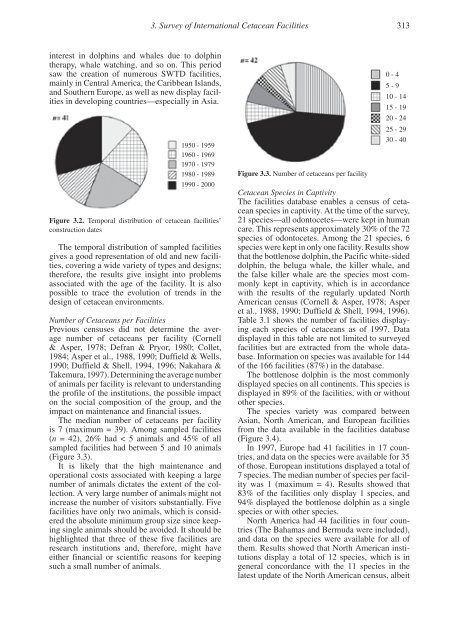Special Issue Survey of Cetaceans in Captive Care
Special Issue Survey of Cetaceans in Captive Care
Special Issue Survey of Cetaceans in Captive Care
Create successful ePaper yourself
Turn your PDF publications into a flip-book with our unique Google optimized e-Paper software.
3. <strong>Survey</strong> <strong>of</strong> International Cetacean Facilities 313<strong>in</strong>terest <strong>in</strong> dolph<strong>in</strong>s and whales due to dolph<strong>in</strong>therapy, whale watch<strong>in</strong>g, and so on. This periodsaw the creation <strong>of</strong> numerous SWTD facilities,ma<strong>in</strong>ly <strong>in</strong> Central America, the Caribbean Islands,and Southern Europe, as well as new display facilities<strong>in</strong> develop<strong>in</strong>g countries—especially <strong>in</strong> Asia.1950 - 19591960 - 19691970 - 19791980 - 19891990 - 2000Figure 3.2. Temporal distribution <strong>of</strong> cetacean facilities’construction datesThe temporal distribution <strong>of</strong> sampled facilitiesgives a good representation <strong>of</strong> old and new facilities,cover<strong>in</strong>g a wide variety <strong>of</strong> types and designs;therefore, the results give <strong>in</strong>sight <strong>in</strong>to problemsassociated with the age <strong>of</strong> the facility. It is alsopossible to trace the evolution <strong>of</strong> trends <strong>in</strong> thedesign <strong>of</strong> cetacean environments.Number <strong>of</strong> <strong>Cetaceans</strong> per FacilitiesPrevious censuses did not determ<strong>in</strong>e the averagenumber <strong>of</strong> cetaceans per facility (Cornell& Asper, 1978; Defran & Pryor, 1980; Collet,1984; Asper et al., 1988, 1990; Duffield & Wells,1990; Duffield & Shell, 1994, 1996; Nakahara &Takemura, 1997). Determ<strong>in</strong><strong>in</strong>g the average number<strong>of</strong> animals per facility is relevant to understand<strong>in</strong>gthe pr<strong>of</strong>ile <strong>of</strong> the <strong>in</strong>stitutions, the possible impacton the social composition <strong>of</strong> the group, and theimpact on ma<strong>in</strong>tenance and f<strong>in</strong>ancial issues.The median number <strong>of</strong> cetaceans per facilityis 7 (maximum = 39). Among sampled facilities(n = 42), 26% had < 5 animals and 45% <strong>of</strong> allsampled facilities had between 5 and 10 animals(Figure 3.3).It is likely that the high ma<strong>in</strong>tenance andoperational costs associated with keep<strong>in</strong>g a largenumber <strong>of</strong> animals dictates the extent <strong>of</strong> the collection.A very large number <strong>of</strong> animals might not<strong>in</strong>crease the number <strong>of</strong> visitors substantially. Fivefacilities have only two animals, which is consideredthe absolute m<strong>in</strong>imum group size s<strong>in</strong>ce keep<strong>in</strong>gs<strong>in</strong>gle animals should be avoided. It should behighlighted that three <strong>of</strong> these five facilities areresearch <strong>in</strong>stitutions and, therefore, might haveeither f<strong>in</strong>ancial or scientific reasons for keep<strong>in</strong>gsuch a small number <strong>of</strong> animals.Figure 3.3. Number <strong>of</strong> cetaceans per facility0 - 45 - 910 - 1415 - 1920 - 2425 - 2930 - 40Cetacean Species <strong>in</strong> CaptivityThe facilities database enables a census <strong>of</strong> cetaceanspecies <strong>in</strong> captivity. At the time <strong>of</strong> the survey,21 species—all odontocetes—were kept <strong>in</strong> humancare. This represents approximately 30% <strong>of</strong> the 72species <strong>of</strong> odontocetes. Among the 21 species, 6species were kept <strong>in</strong> only one facility. Results showthat the bottlenose dolph<strong>in</strong>, the Pacific white-sideddolph<strong>in</strong>, the beluga whale, the killer whale, andthe false killer whale are the species most commonlykept <strong>in</strong> captivity, which is <strong>in</strong> accordancewith the results <strong>of</strong> the regularly updated NorthAmerican census (Cornell & Asper, 1978; Asperet al., 1988, 1990; Duffield & Shell, 1994, 1996).Table 3.1 shows the number <strong>of</strong> facilities display<strong>in</strong>geach species <strong>of</strong> cetaceans as <strong>of</strong> 1997. Datadisplayed <strong>in</strong> this table are not limited to surveyedfacilities but are extracted from the whole database.Information on species was available for 144<strong>of</strong> the 166 facilities (87%) <strong>in</strong> the database.The bottlenose dolph<strong>in</strong> is the most commonlydisplayed species on all cont<strong>in</strong>ents. This species isdisplayed <strong>in</strong> 89% <strong>of</strong> the facilities, with or withoutother species.The species variety was compared betweenAsian, North American, and European facilitiesfrom the data available <strong>in</strong> the facilities database(Figure 3.4).In 1997, Europe had 41 facilities <strong>in</strong> 17 countries,and data on the species were available for 35<strong>of</strong> those. European <strong>in</strong>stitutions displayed a total <strong>of</strong>7 species. The median number <strong>of</strong> species per facilitywas 1 (maximum = 4). Results showed that83% <strong>of</strong> the facilities only display 1 species, and94% displayed the bottlenose dolph<strong>in</strong> as a s<strong>in</strong>glespecies or with other species.North America had 44 facilities <strong>in</strong> four countries(The Bahamas and Bermuda were <strong>in</strong>cluded),and data on the species were available for all <strong>of</strong>them. Results showed that North American <strong>in</strong>stitutionsdisplay a total <strong>of</strong> 12 species, which is <strong>in</strong>general concordance with the 11 species <strong>in</strong> thelatest update <strong>of</strong> the North American census, albeit


